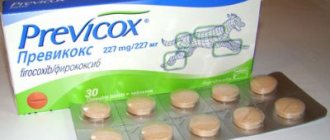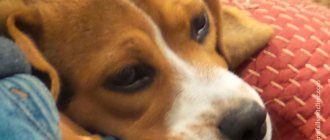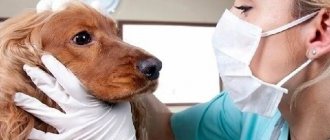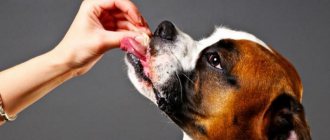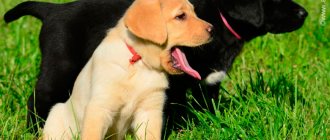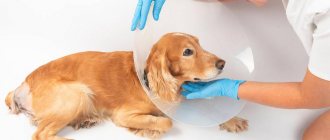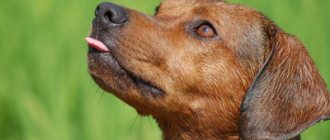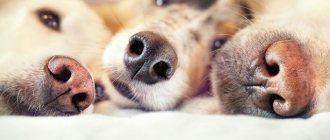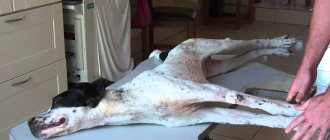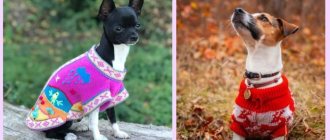A single sneeze from a pet not only does not frighten, but also touches. Because of this, videos of sneezing animals get quite a lot of views and likes.
But a completely different picture is typical for reverse, or reverse, sneezing in dogs. This syndrome can plunge unprepared owners into real horror, since its symptoms are very similar to a number of dangerous diseases.
What happens to a dog when he reverse sneezes?
Dog owners often turn to veterinary cardiologists because their pets are breathing abnormally, sometimes coughing strangely, and sneezing just as strangely. At such moments, as the owners explain, it seems as if the dog is choking or suffocating. When the attack passes, breathing is restored.
Doctors consider the reverse method of sneezing to be a reverse type of cough and also call it paroxysmal breathing. It's more like a dog gagging. She wants to sneeze, but instead takes several short and convulsive breaths, with grunts and sniffles. If during a normal sneeze the air is suddenly and sharply exhaled through the nostrils, then during the reverse sneezing it is instantly drawn in through the nasal passages. The spasm causes a narrowing of the airways, making it difficult for air to enter the lungs.
Reverse sneezing is called paroxysmal breathing
Reverse sneezing can be recognized by the following symptoms:
- the dog's head is thrown back (and not forward and down, as with normal sneezing);
- The mouth is open and, swallowing saliva, the dog wheezes and gags.
Everything happens noisily and lasts up to 60 seconds.
What does it look like
It's quite easy to identify him. After all, every person has seen a sneezing dog. Here the picture is exactly the same, but the sneezing itself does not look like a sharp exhalation, but like an inhalation. Moreover, most often a whole series of similar sneezes occurs. Usually such convulsive breaths are accompanied by grunting or snorting. In some cases, dogs stretch their necks, lie on their stomachs, fall on their front paws, or tense their pectoral muscles. Some breeds may experience an increased amount of saliva produced.
The duration of attacks is rarely long - they are almost always limited to one minute or even less. Once completed, the dog behaves normally, showing no symptoms of pain or discomfort.
But outwardly it looks quite scary - an inexperienced owner may immediately think that the dog is having some kind of dangerous attack or is suffocating. However, there is usually no reason for concern and an immediate visit to the veterinarian; as long as you dial the phone or look for the car keys, the symptoms of reverse sneezing in your dog will pass.
Causes of reverse sneezing
The causes of reverse sneezing as a physiological phenomenon have not been fully established, but episodes of paroxysmal breathing are believed to occur due to the following factors:
- sticking of the epiglottis and larynx;
- specific anatomy of the nasopharynx;
- the presence of hypertrophied tissues of the soft palate.
Reverse sneezing may be caused by allergies.
The following are identified as provoking factors:
- strong odors and dust, as well as cigarette smoke and fumes from household chemicals;
- allergenic substances;
- nervous excitement;
- haste while eating and drinking;
- tight collar.
Attention! In some cases, reverse sneezing can occur from a sudden temperature change, for example, when a dog enters a house from the street in winter.
What breeds does it occur in?
Reverse breathing in dogs can occur in any breed. This feature is most often found in small dogs. The following small breeds are prone to reverse breathing:
- York;
- chihuahua;
- pug;
- French Bulldog;
- Boston Terrier;
- beagle;
- Shih Tzu;
- Pekingese;
- Toy Terrier.
Snot in a dog: causes of runny nose and what to do
Reverse sneezing is not associated with breed characteristics, but brachycephals - animals with a short skull and flattened muzzle - are susceptible to this condition.
Important! Symptoms of reverse sneezing in Pugs, French Bulldogs and Pekingese can easily be confused with signs of brachiocephalic syndrome. Owners of such dogs need to be very careful. After an attack, your pet should be seen by a doctor.
Dogs with short muzzles are more prone to reverse sneezing.
Risk group
There are dog breeds that are predisposed to respiratory problems, including reverse sneezing. We are talking about animals with a brachycephalic head structure:
- Griffons and Pekingese;
- pugs and bulldogs;
- other breeds with a characteristic skull shape.
Bulldogs are predisposed to breathing problems
These animals suffer from what is known as brachiocephalic syndrome, a set of symptoms that are caused by physiologically significant narrowing of the nostrils and nasal passages, as well as an overly long or thick soft palate, coupled with an abnormally shaped larynx and/or trachea.
On a note! The narrower the airways, the more the dog suffers. Against the background of reverse sneezing, wheezing, grunting and other breathing problems that occur constantly, hypoxia develops, which confirms the cyanosis of the oral mucosa. Brachiocephalic manifestations intensify with emotional stress, heat, significant physical activity, and pain.
The structure of the skull in a brachycephalic breed
Predisposition to OC
Most often, it is dogs that suffer from OC. This syndrome practically does not occur in cats with similar anatomical features.
Pedigree
The risk group includes brachycephalic dogs (pugs, bulldogs, Pekingese, Shih Tzu, Japanese Chins, Boxers) and some small breeds (Yorkies, Toy Terriers, Chihuahuas). All these animals are united by the atypical structure of the respiratory organs.
Physiological
Brachycephals are distinguished by their deformed skull with a flattened muzzle. Their nasal passages are narrower and shorter than those of other breeds. This structure interferes with natural air circulation, so they often snore and get tired faster when running.
Brachycephalics also have an elongated soft palate. When you inhale sharply before a sneeze, it is sucked into the windpipe, causing irritation.
In small breed dogs, reverse sneezing syndrome occurs due to another feature. The cartilaginous rings of their trachea are narrower than normal, making it much more difficult for air to get inside the lungs. This can also cause throat irritation.
Contacting a veterinarian
Consultation with a doctor is required if your dog frequently sneezes in this manner. The reasons for this behavior may be the following diseases:
- hypertrophic growth of palatal tissue, which can be caused by tumor processes. This is especially true for older animals;
- allergic reaction, it is important to find out what causes it. Veterinarians believe that antihistamines are vital for such dogs. Increased sensitivity to allergens is manifested not only by sneezing, but also by other signs. This means that the whole body suffers. In addition, dogs with this problem are at risk for anaphylactic shock, a condition that develops suddenly and can cause sudden death. You can read about allergic manifestations in dogs below.
Allergy symptoms in dogs
It happens that in addition to the opposite, regular sneezing and coughing are also observed. If this is accompanied by copious nasal discharge, it may be an infection.
On a note! If, during a sneezing attack, the mucous membranes of the oral cavity turn blue or pale, and the animal faints, respiratory or heart failure is possible. Both are symptoms of dangerous diseases.
A visit to the veterinary clinic will help you understand the causes of reverse sneezing and the accompanying symptoms. Based on the results of the examination, the doctor will prescribe treatment.
If you do see a doctor
Is your dog experiencing any of the warning signs listed above? In this case, it is still worth contacting a veterinarian. It’s better for him to examine the patient, take payment and reassure you that the dog is healthy and in great shape, than for a dangerous disease to be neglected, time wasted and this will cause a serious illness or even the death of the dog.
By the way, when turning to specialists, it will be useful not only to talk about the symptoms, but also to demonstrate them. Of course, a dog will not sneeze when ordered. But most owners today have smartphones with very good cameras. By recording a sneezing attack on video, you can make the veterinarian’s job much easier. An experienced specialist, having looked at such a recording, will say with a high degree of confidence whether this is ordinary reverse sneezing or whether there are other symptoms that pose a great danger to the pet’s life.
Diagnostics
Diagnostics aims to find out the causes of paroxysmal breathing in an animal and differentiate (distinguish) the condition from ordinary coughing and sneezing. In some cases, the study reveals pet pathologies that the owner was not aware of. In the doctor's office, one can only guess how exactly a dog sneezes at home - classically or vice versa. Not every owner can describe the details correctly.
Only a veterinarian can accurately determine the cause and prescribe the correct treatment.
The doctor will first check to see if there is a foreign body in the dog’s respiratory tract, and then, given that normal sneezing can be a sign of pathology, he will suggest examining the dog for certain ailments, such as:
- diseases of the mouth, nose, throat and lower respiratory tract;
- adenoviral, herpetic, parasitic and other infections (if symptoms are present).
A situation in which:
- Episodes of reverse sneezing occur in puppies or young animals. This may indicate the onset of bronchial asthma;
- The dog sneezes this way often. Especially if this happens several times a day, despite the fact that the surrounding air does not have a strong odor and does not contain mechanical particles that, after entering the respiratory tract, could cause their spasm.
Episodes of reverse sneezing most often occur in puppies
The likelihood of health problems in such pets is high, so it is recommended that they be fully examined.
When do you need veterinary help?
Despite the apparent harmlessness of reverse sneezing, this phenomenon can hide certain problems inherent in breeds such as the Japanese Chin and other dogs with brachycephalic syndrome.
In what cases is specialist help required:
- Japanese Chin sneezes too often.
- Cough is added to the main symptoms.
- Starting to sneeze, the Japanese Chin begins to choke.
- Loss of consciousness in a dog.
- Change in color of mucous membranes (become bluish or pale).
- Bloody or purulent discharge from the nose.
- The appearance of foam from the mouth.
Since reverse sneezing can be confused with specific diseases of brachycephalic dogs, which sometimes require surgical intervention, if the slightest suspicion arises, you should consult a veterinarian. In addition to anatomical problems, sneezing is also provoked by tumors in the nasopharynx or foreign objects.
Other causes of the syndrome may be:
Microbes and bacteria that colonize the mucous membranes of the mouth and nasal passages (usually accompanied by fever, lethargy and refusal to eat). Allergens. Japanese Chins, which are predisposed to allergies to food components (certain types of protein), are also at risk.
Dogs infected with worms are susceptible to attacks of reverse sneezing (at night).
In puppies, the syndrome is extremely rare and may indicate the presence of bronchial asthma.
Since Chin owners are often confused in describing the essence of the problem, it is recommended to make a video recording of one of the dog’s attacks, from which a specialist will be able to distinguish reverse sneezing from a serious pathology and make the correct diagnosis.
Forewarned is forearmed
Taking into account all of the above, owners of both Japanese Chins and other dog breeds susceptible to the syndrome should be attentive to their pets and do everything possible to ensure that reverse sneezing occurs as rarely as possible.
Prevention and care measures:
Do not overcool or overheat the dog.
Avoid stressful situations.
Regular walks in comfortable weather and a well-structured diet will help strengthen your immune system and be the key to good health.
Do not use perfume with a strong smell, avoid using strong-smelling household chemicals.
For Japanese Chins, a harness is more suitable than a collar.
Timely vaccination and deworming will reduce the risk of developing the syndrome.
In the room where the chin lives, it is necessary to regularly carry out wet cleaning.
It is important:
The doors of veterinary clinics are not only open to dogs that need to be treated. A preventive examination of both puppies and adults will help prevent possible health problems, and sound advice on the care and maintenance of a dog will guide the owner on how to remain calm in any situation.
Treatment Options
Depending on the dog's condition and the context in which the sneezing occurs, two types of treatment may be prescribed to the animal:
- conservative;
- surgical.
Conservative
Animals prone to allergies must be protected from contact with the source of problems. For example, when a pet reacts by sneezing (reverse and not only) to spraying hairspray, it is better to make the bathroom beautiful. In addition, the dog will need a course of antihistamines. The name, dosage and duration of treatment are determined by the doctor.
Animals prone to allergies must be protected from the allergen
For infectious pathologies, the following medications are indicated:
- medications that help strengthen the immune system;
- antibacterial drugs, which are ideally selected depending on the type of pathogen. Alternatively, broad-spectrum antibiotics may be prescribed;
- antifungal medications;
- means of general strengthening action.
Treating co-infections speeds up relief from reverse sneezing
After eliminating the pathology-cause, attacks of reverse sneezing stop bothering the dog.
Animals with anatomical features of the skull are more at risk than others of respiratory disorders, which develop suddenly and can be very dangerous.
Table 1. Drugs for dogs with brachiocephalic syndrome
| Name of the drug | Image | Action |
| Lasix, Furosemide or other diuretics | Lasix | Diuretic. Helps relieve swelling, including swelling of the respiratory system, removes excess fluid from the body |
| Dexamethasone or Prednisolone | Dexamethasone | Corticosteroids to quickly eliminate massive laryngeal edema. In severe cases, the use of one of these drugs gives a chance to take the animal to a veterinarian. Effective for sudden attacks of allergies, including shock conditions |
| Tavegil | Tavegil | An antihistamine to eliminate the symptoms of an acute allergic reaction |
It is important to know! The listed drugs should be on hand in the form of ampoules with injection solutions, since in emergency cases it is important that the medicine gets into the blood as quickly as possible. In addition, a dog suffering from a choking attack is unlikely to be able to swallow the pill.
Surgical
If the problem is in the anatomy of the respiratory tract, it is solved surgically. Indications for surgery are usually manifestations of brachiocephalic syndrome that contribute to hypoxia, and therefore are life-threatening. In such cases, plastic surgery of the nostrils is performed, and, if necessary, the velum palatine, as well as the laryngeal sacs. Everything happens as planned, after the swelling has been eliminated and the condition has stabilized. The intervention itself is not considered difficult, but the postoperative period is dangerous due to respiratory failure if the swelling returns. To minimize risks, the animal is given a tracheostomy through which it will breathe for the first time after surgery.
Anatomy of the dog's respiratory tract
Is it treatable?
Alas, it is impossible to give a definite answer to this question. First you need to understand what exactly is the cause - this will be determined during the diagnosis. Infectious diseases are cured with appropriate medications; dental problems are most often cured by removing them. If the cause is a deformed soft palate, you will have to put up with the attacks.
In cases where dogs have an allergic reaction, you will have to ventilate your home more thoroughly to get rid of the unpleasant odor or particles in the air that cause the attack. But it is better to refuse to use drugs that cause allergies, or to temporarily isolate the dog in a room where they are not used. For example, if you decide to varnish a table in the kitchen, lock your pet in the bedroom until the varnish dries and the smell disappears.
How to relieve your pet's seizure
If an animal suffers from frequent attacks, it can be helped. This is done like this:
- the dog is stroked on the neck in the larynx area. This stimulates swallowing movements, relaxes the throat muscles, and also allows the pet to restore normal breathing;
- Gently cover the dog’s nostrils with your palm so that he begins to breathe through his mouth. After a deep breath, the attack will stop. If this does not happen, it is recommended to try again, while stroking the dog’s throat with the other hand.
During an attack, you need to stroke the dog on the neck in the larynx area
The following actions are also considered as alternative assistance options:
- grab the dog's nose and blow into the nostrils;
- give the animal water.
This is usually enough for the dog to calm down and breathe evenly.
You can see what happens to an animal during an attack of reverse sneezing and how to help it here:
